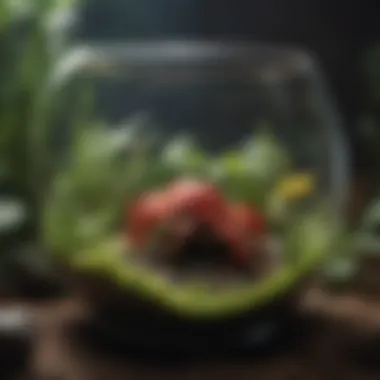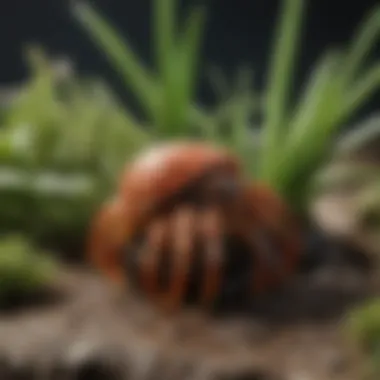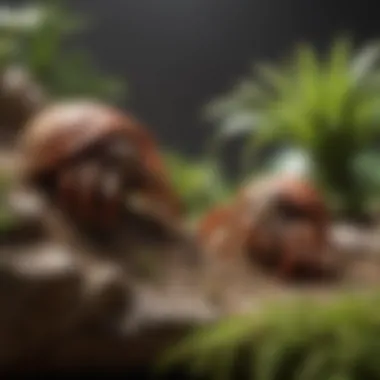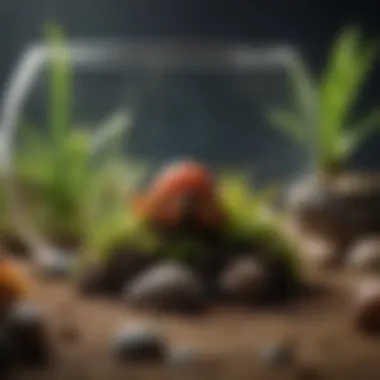Essential Guide to Plants for Hermit Crabs


Intro
Understanding the relationship between hermit crabs and their plant environments is crucial for any pet owner. This section explores how integrating the right plant species can significantly enhance the quality of life for hermit crabs. The right plants can provide shelter, encourage natural behaviors, and improve overall habitat conditions. This guide will cover essential plant selections, care requirements, and tips for creating an optimal habitat for hermit crabs.
Pet Care and Grooming
Importance of Regular Care
Regular care is vital for the well-being of hermit crabs. They thrive in environments that mimic their natural habitats. Consistent maintenance ensures that their plants remain healthy and the terrarium is clean. Without proper care, the ecosystem can become unstable, leading to stress or health issues in hermit crabs.
Grooming Techniques
Grooming hermit crabs entails regular check-ups to monitor their health. Some common techniques include examining shells for wear or damage and ensuring that the claws are intact. Pet owners should also be vigilant about the substrate used in the terrarium. A clean substrate minimizes potential health risks.
Tools and Products Recommendations
To maintain a healthy plant environment for hermit crabs, specific tools and products are recommended. A gentle spray bottle for misting, a small shovel for substrate management, and a soft brush for cleaning shells can be beneficial. Additionally, consider using aquarium-safe fertilizers to promote plant growth.
Seasonal Care Tips
During different seasons, care routines may need to be adjusted. In warmer months, ensure plants receive adequate water and light. In cooler months, it’s important to monitor humidity levels closely, as they can drop significantly. Incorporating a thermometer and hygrometer can help maintain optimal conditions.
“Healthy plants contribute to the overall stability of the terrarium ecosystem.”
Health and Nutrition
Understanding Pet Nutrition
Nutrition is key for hermit crabs. Their diet should consist of a balance of protein, calcium, and fiber. Plant materials can serve as a significant part of their diet. Leafy greens and shredded carrots are excellent options. Always ensure that any plant materials offered are free from pesticides.
Common Health Issues by Species
Different species of hermit crabs might suffer from unique health issues. Common problems include shell diseases and molting issues. Identifying symptoms early can lead to better health outcomes. Regular observation allows pet owners to react promptly when any abnormalities are noticed.
Preventive Care and Regular Check-Ups
Establishing a routine for observing hermit crab behaviors can prevent health issues. It is advisable to perform semi-annual check-ups and ensure that conditions in the terrarium remain optimal. These practices allow for early detection of potential problems before they become serious.
Food and Dietary Advice
Offering a varied diet is essential. Many hermit crab owners incorporate different plant-based foods for hydration and nutrition. Choose fresh fruits like apples and bananas as treats. Create a rotation of treats to ensure a balanced diet.
Behavioral Training
Basics of Positive Reinforcement
Training hermit crabs requires a gentle approach. Positive reinforcement is effective. When crabs exhibit desired behaviors, rewards such as food or new shells encourage repetition of those behaviors.
Training Techniques Users Can Apply
Introduce interactive toys or challenge pathways to motivate exploration. Use light or sound to encourage activity. Simple training can help keep hermit crabs stimulated and engaged in their habitat.
Managing Behavioral Issues
Sometimes hermit crabs may display behavioral changes, such as lethargy or aggression. Observing their environment can help identify stressors, such as overcrowding or inadequate hiding places. Adjusting their habitat can alleviate these issues.
Importance of Socialization
Socializing hermit crabs is beneficial. Allowing them to interact with each other can mimic natural behavior and promote healthy social habits. Ensure there's ample space for each crab to flourish.
Engaging Activities and Enrichment
Fun Games to Play with Your Pet
Creating opportunities for interaction can enhance your hermit crab's quality of life. Set up small obstacle courses or hide treats within their enclosure. These activities encourage exploration and activity.


DIY Toys and Activities
Crafting toys from everyday materials can stimulate hermit crabs. Items such as cardboard boxes or paper towel rolls can be turned into hideaways or tunnels. This can provide a sense of security.
Importance of Mental Stimulation
Mental stimulation is essential for pet hermit crabs. Changing their habitat layout occasionally can provoke curiosity. Introducing new plants or decorations can also keep them engaged.
Outdoor Adventures and Exploration
If suitable, supervised outdoor time can be beneficial. Ensure that the environment is controlled to prevent escapes or exposure to harmful substances. Seeking out natural stimulation can improve their overall health.
Resources and Community Engagement
Recommended Books and Websites
For further reading, consider books like Hermit Crab Care and visit websites such as en.wikipedia.org or britannica.com for comprehensive resources on hermit crabs and their care.
Forums and Groups for Pet Owners
Connecting with other hermit crab enthusiasts can provide valuable insights. Platforms like reddit.com and facebook.com have dedicated groups for sharing experiences and advice.
Finding Local Services and Classes
Many local pet stores offer workshops on caring for hermit crabs. Seeking local resources can provide direct support and education.
Encouraging Community Sharing and Contributions
Communities thrive on shared knowledge. Encouraging members to share their experiences and tips can foster a deeper understanding of hermit crab care. This shared knowledge benefits all.
Prelude to Hermit Crab Habitats
Hermit crabs are fascinating creatures that require a well-structured habitat for their overall health and wellbeing. Understanding their living environment is crucial for pet owners and those interested in adopting these unique pets. The conditions of their habitat can directly affect their behavior, growth, and longevity.
Natural Habitat of Hermit Crabs
In the wild, hermit crabs inhabit coastal regions. They typically are found in sandy beaches, mangroves, and scrub forests. Their natural habitat features a blend of land and aquatic environments which provide moisture and food. The presence of vegetation plays a vital role in these ecosystems.
Hermit crabs often use plants for shelter and protection. They also depend on natural debris and leaf litter for food. Understanding the intricacies of their natural habitat can help in replicating it in residential settings. This includes mimicking the variations in humidity, temperature, and light exposure that they naturally encounter.
Importance of Vegetation
Vegetation serves many purposes in hermit crab habitats. First, plants provide hiding spaces and security. Hermit crabs can often feel threatened and thus require places to retreat. Without sufficient plant life, they may become stressed.
Moreover, plants contribute to the overall ecosystem health. They help in maintaining optimal humidity levels, which is essential for hermit crabs. Besides, plants can improve air quality by producing oxygen. This contributes to a more natural and balanced environment. The soil enriched by plant activity supports microbial life, which further aids in breaking down waste materials.
The selection of suitable plants is paramount. Some species thrive better than others in similar environments. Knowing which plants can coexist well in hermit crab habitats makes a significant difference in their quality of life. Thus, understanding the relationship between hermit crabs and vegetation is a fundamental step for any potential owner willing to enhance their crustaceans' lives.
Types of Plants Suitable for Hermit Crabs
Understanding the types of plants suitable for hermit crabs is vital for creating a thriving habitat. Plants not only enhance the aesthetic appeal of the terrarium, but they also play an integral role in the overall health and wellbeing of these creatures. Different types of plants provide unique benefits, which can significantly affect how a hermit crab behaves and how well it thrives in captivity.
Land Plants
Land plants are essential for a hermit crab's habitat. They mimic the natural environment that hermit crabs enjoy. Common choices include coconut palm, bromeliads, and pothos. These plants offer hiding spots, climbing opportunities, and environmental enrichment, which encourage natural behavior.
When selecting land plants, consider the following:
- Light Requirements: Ensure the plants selected fit within the lighting conditions of the terrarium.
- Growth Rate: Some plants grow quickly and may require frequent trimming.
- Compatibility: Verify that the plants are non-toxic and safe for the crabs.
Uing land plants improves air quality as they absorb carbon dioxide and release oxygen. This is beneficial for the hermit crabs, ensuring a safer and healthier living space.
Aquatic Plants
Aquatic plants can be included in coastal setups for hermit crabs that enjoy being near water. Common selections like Java fern and Anubias provide aesthetic appeal and can also enhance water quality. They help in maintaining a balanced ecosystem by filtering water and providing oxygen.


Points to think about:
- Depth: Determine how deep the water is, as some plants prefer shallow areas.
- Water Temperature: Ensure the plants are suitable for the same conditions that hermit crabs require.
- Size: Choose plants that do not overpower the aquatic environment.
Utilizing aquatic plants can simulate a more diverse habitat, encouraging hermit crabs to explore and engage in behaviors similar to their natural environment.
Edible Plants
Incorporating edible plants into a hermit crab's diet enhances its nutrition. Items like clover, dandelion greens, and spinach not only nourish crabs but also offer additional engagement through foraging. Edible plants can serve dual purposes, providing food while creating a more enriching environment.
When adding edible plants:
- Freshness: Ensure the plants are organic and free of pesticides.
- Variety: Offering a mix of plants can keep the crabs interested and provide a balanced diet.
- Availability: Choose plants that are easy to source or grow at home.
Benefits of Using Live Plants
The presence of live plants in a hermit crab habitat can significantly enhance the quality of life for these animals. Plants serve multiple roles beyond mere decoration; they create a more naturalistic environment that mimics the hermit crab's native habitat. Here are some key benefits of using live plants in hermit crab ecosystems.
Oxygen Production
Live plants are crucial for oxygen production within hermit crab habitats. Through the process of photosynthesis, plants absorb carbon dioxide and release oxygen. This is essential for the wellbeing of hermit crabs. A well-oxygenated environment aids in respiratory functions and promotes overall health, helping crabs thrive. Moreover, the oxygen produced enhances water quality in aquatic settings, establishing a better balance in the terrarium. Even in land habitats, the presence of plants contributes to the air exchange, creating a fresher atmosphere.
Natural Behavior Encouragement
Another significant advantage of incorporating live plants is their role in encouraging natural behaviors in hermit crabs. In the wild, these creatures navigate through vegetation, which provides essential hiding spots and foraging opportunities. By replicating this environment, live plants support activities such as climbing, burrowing, and foraging. This enrichment is vital for preventing stress and ensuring psychological well-being. Additionally, fermented leaf litter can serve as a food source, promoting foraging behavior that is common in their natural habitat.
Humidity Regulation
Maintaining appropriate humidity levels is crucial in hermit crab care, and live plants greatly assist in this area. Plants naturally release moisture into the air through transpiration. This process helps maintain humidity levels within the terrarium, which is essential because hermit crabs thrive in humid environments. Consistent humidity is important for molting and hydration. Therefore, incorporating a variety of live plants not only enhances the habitat aesthetically, but also ensures a stable and comfortable environment for hermit crabs.
In summary, the use of live plants in hermit crab habitats provides numerous benefits; from oxygen production and encouragement of natural behaviors to humidity regulation, they are an integral component of a successful terrarium setup.
Considerations for Artificial Plants
When considering the inclusion of artificial plants in a hermit crab habitat, it’s crucial to evaluate several factors. Selecting the right type of plant can influence the overall well-being of these unique creatures. Artificial plants can provide aesthetic enhancement, but they also come with their own set of challenges.
Durability and Maintenance
One primary advantage of artificial plants is their durability. Unlike live plants, which might wilt or die, artificial versions stay intact regardless of environmental factors. This resilience means less frequent replacements, reducing long-term costs for caregivers.
However, while they are durable, artificial plants require maintenance. Dust and debris can accumulate on their surfaces, making regular cleaning essential to maintain appearances and prevent bacteria buildup. It would be wise to wash them occasionally with mild soap and water. Use a soft brush to remove any stubborn residues that might compromise the habitat’s cleanliness.
Safety Concerns
Safety is of utmost importance when choosing artificial plants for hermit crab habitats. Not all artificial plants are suitable for hermit crabs. Some may contain harmful chemicals or materials that could be toxic if ingested. It’s crucial to select products made from non-toxic materials that won't leach harmful substances into the environment. Always check products for certifications or labeling that specify they are safe for pets.
In addition, the design of the plants matters. Sharp edges or small detachable parts could pose a choking hazard or cause injury to the crabs. Opt for smooth surfaces and secure attachments to eliminate potential risks.
Aesthetic Versus Functional Aspects
When integrating artificial plants into a hermit crab’s habitat, one must balance aesthetic appeal with functional benefits. The visual aspect can enhance the terrarium's appearance. A well-planned design can mimic a natural environment, which may positively affect the crabs’ behavior and psychological health.
Nevertheless, functionality cannot be overlooked. Artificial plants should provide hideaways and climbing opportunities, similar to their natural counterparts. Consider the height, breadth, and material when selecting plants, ensuring they serve the needs of the hermit crabs effectively.
A successful habitat combines beauty with practicality, fostering a stimulating environment for hermit crabs while meeting their biological needs.
Creating the Ideal Plant Environment
Creating an ideal plant environment is essential for the well-being of hermit crabs. These creatures rely on their habitats to mimic natural conditions, enhancing their overall health and behavior. A well-planned environment not only supports plant life but also offers a comfortable space for hermit crabs to thrive.
Selecting Proper Substrates
Selecting the right substrate is a fundamental aspect of creating a functional habitat. A suitable substrate should not only provide a natural appearance but also support the plants' growth. A mixture of coconut coir, sand, and topsoil can effectively create a balanced environment. Organic matter encourages beneficial microbes while providing structure. It's essential to avoid substrates with chemical additives, as these can be harmful to both plants and hermit crabs. Additionally, the substrate should retain moisture without becoming waterlogged. This balance is key to ensuring healthy plant growth and providing a comfortable space for the crabs.
Lighting Considerations


Proper lighting is a crucial part of maintaining a healthy plant environment. Natural light mimics the conditions found in the wild, promoting photosynthesis in plants. If natural light is insufficient, artificial lighting can supplement it. LED grow lights work well because they emit appropriate wavelengths for plant growth while remaining energy-efficient. When setting up the lighting, position it to provide even coverage across the terrarium. This ensures that all plants, regardless of their location, receive adequate light.
Setting Up a Terrarium
Setting up a terrarium requires careful planning and execution. Begin with a clean container that provides enough space for both the plants and hermit crabs. It's advisable to create layers in the terrarium: start with a drainage layer, followed by the substrate, and finally place the plants. Ensure adequate ventilation, as both crabs and plants need air circulation. Include decorative elements like rocks or driftwood; these can enhance the environment and offer climbing opportunities for the crabs. This configuration not only beautifies the habitat but also promotes natural behaviors, like burrowing or exploration.
Important: Regularly monitor the terrarium conditions. Keeping track of temperature, humidity, and plant health can greatly benefit both the plants and the hermit crabs. Adjusting these factors as needed creates a thriving ecosystem for all inhabitants.
Watering and Nutritional Needs
Understanding how to care for plants within a hermit crab habitat is essential for the overall well-being of the crabs. Proper watering and nutrition play vital roles in creating a sustainable environment that meets both plant and hermit crab needs. This section emphasizes the components involved in managing soil moisture and implementing fertilization strategies, which will ensure a thriving ecosystem.
Soil Moisture Levels
Maintaining the right soil moisture levels is crucial in a hermit crab habitat. Plants need water to grow, and hermit crabs will benefit from the humidity that moisture provides. Plants should not be overwatered, as soggy soil can lead to root rot, which threatens plant health and indirectly affects the crabs. However, it's equally important to prevent the soil from becoming too dry, as this can stress the plants and lead to inadequate oxygen levels in the substrate.
To find the optimal soil moisture level, consider the following:
- Check Soil Texture: Use your fingers to feel the soil. It should be slightly moist but not wet.
- Observe Plant Appearance: Healthy plants have vibrant colors and firm leaves. If they start to wilt or turn yellow, it may indicate a moisture issue.
- Humidity Considerations: Hermit crabs thrive in humid environments. Utilize a humidity gauge to monitor levels, ensuring they stay between 70% to 80%.
Fertilization Basics
Fertilization may seem complex, but it is a manageable process for enriching plant soil in your hermit crab's habitat. Well-nourished plants not only enhance the aesthetic of the environment, they also improve the overall ecosystem that supports your hermit crabs. However, it is important to use the right type of fertilizer that is safe for both plants and crabs.
Here are some essential considerations for fertilization:
- Type of Fertilizer: Opt for organic fertilizers. Such products typically have lower risks of chemical toxicity, blending naturally into the soil environment. Fish emulsion or seaweed extracts can be viable choices.
- Application Frequency: Generally, fertilizers should be applied once a month. However, adjust based on your plant species and soil condition. Always follow package instructions.
- Observation: Monitor your plants for signs of nutrient deficiencies, which may involve yellowing leaves or stunted growth. Adjust your fertilization routine accordingly.
Tip: Always test any new fertilizer in a small area before widespread application to ensure compatibility with your plants.
Effective watering and nutritional strategies can significantly influence the success of plant life in hermit crab habitats. A well-tended environment not only supports healthy plants but also contributes to the overall happiness and welfare of hermit crabs.
Pest Management and Plant Health
Maintaining plant health in hermit crab habitats is essential. This section explores pest management and its impact on plant well-being. Pests can threaten both live plants and the hermit crabs themselves. Understanding how to identify and tackle these issues is a key step in ensuring a thriving environment for the hermit crabs.
Identifying Common Pests
Various pests can infest hermit crab terrariums. Some common ones include:
- Aphids: Small, soft-bodied insects that suck sap from plants. They can be green, black, or even reddish.
- Spider Mites: Tiny arachnids that leave fine webs and cause stippling on leaves.
- Mealybugs: White, cotton-like pests that can cluster in leaf axils and on stems.
- Fungus Gnats: Small flies whose larvae thrive in moist soil, they can damage roots.
Recognizing these pests early is crucial. Look for signs like yellowing leaves, wilting, or the presence of insects. Regular inspection of the plants can help catch infestations promptly.
Prevention Techniques
Preventing pests is more effective than dealing with infestations after they occur. Here are some notable techniques:
- Quarantine New Plants: Isolate any new plants for a couple of weeks before introducing them to the habitat. This helps to prevent any hitchhiking pests from infecting existing plants.
- Regular Cleaning: Keep the terrarium clean. Remove any dead plant matter and debris that can harbor pests.
- Proper Watering: Overwatering can create a breeding ground for pests. Ensure pots have drainage and that the soil moisture levels are appropriate.
- Natural Predators: Consider introducing beneficial insects, like ladybugs, that can help control pest populations without chemicals.
Preventive measures not only protect plant health but also contribute to a healthy habitat for your hermit crabs.
Signs of Plant Stress in Hermit Crab Habitats
Understanding signs of plant stress is essential for maintaining a healthy environment for hermit crabs. Plants play a significant role in the ecosystem of these creatures. When plants show signs of stress, it can lead to detrimental effects on the entire habitat. Recognizing these indicators early can help in ensuring that the plants remain healthy and continue to provide the necessary support for the hermit crabs.
Understanding Plant Health Indicators
There are several key indicators that pet owners should monitor to assess the health of plants in a hermit crab habitat. Common signs of stress may be:
- Discoloration: Leaves may turn yellow or brown. This can indicate issues such as inadequate nutrients or excess moisture.
- Wilting Leaves: If the leaves droop or wilt, it can be a sign of water deficiency or excess. Both extremes can harm plants, making proper watering critical.
- Stunted Growth: When plants fail to grow, it can signal insufficient light or nutrient deficiencies.
- Pests and Mold: The presence of pests or mold can also be a clear sign of stress. This denotes an imbalance in the ecosystem that needs to be addressed promptly.
Regular monitoring of plants helps in taking corrective measures before conditions worsen.
It is important for pet owners to become familiar with these indicators. Understanding these signs enables timely interventions, ensuring the plants thrive and the habitat remains stable for the hermit crabs.
In addition to monitoring, conducting routine checks can help in maintaining plant health. By providing the right conditions and taking note of their responses, pet owners can create a balanced ecosystem that supports both plant life and hermit crabs effectively.
Concluding Thoughts on Hermit Crab Plants
In summarizing the content discussed regarding hermit crab plants, it becomes clear that their role in the habitat of hermit crabs is multifaceted and crucial. A suitable selection of plants not only enhances the aesthetic appeal of the terrarium but also contributes significantly to the well-being of these crustaceans. The interplay between live plants and the ecosystem mimics natural conditions that hermit crabs are accustomed to and encourages their inherent behaviors. Therefore, understanding the importance of plant life in creating a thriving environment cannot be overlooked.















